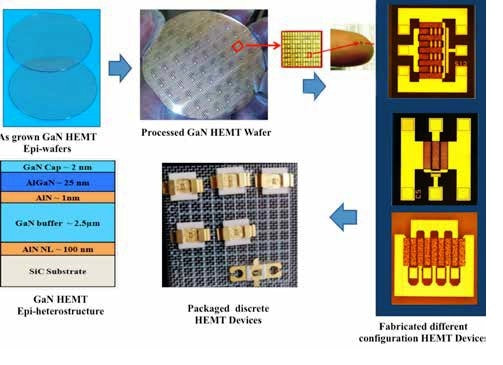Gallium Nitride (GaN)-based High Electron Mobility Transistor (HEMT) technology is revolutionizing the modern defence RF and electronic warfare systems. The capability of AlGaN/GaN HEMT to deliver high power, high frequency, high linearity, high efficiency and high temperature performance renders it the most sought after device for applications in advanced radars, data links, satcoms, etc. Particularly for RF power applications, GaN-based HEMT technology offers a significant advantage over the existing gallium arsenide (GaAs) Monolithic Microwave Integrated Circuits (MMICs). This is primarily due to the capability of GaN devices to operate at higher voltages owing to very high breakdown fields associated with them. Additionally, the GaN devices offer much higher impedance resulting in the requirement of less complex matching networks in RF power amplifier integrated circuits.
On the whole, GaN technology results in minimizing the sizes of RF ICs by a factor of ten or even higher over the competing RF technologies. Moreover, the low current operation aided with a higher efficiency results in power saving and reduced costs for cooling the system.
Therefore, the GaN-based power amplifiers constitute the heart of present day transceiver (T/R) modules in AESA (Active Electronically Scanned Array) radars and communication systems. To harness the potential of this technology, a project entitled AlGaN/GaN High Electron Mobility Transistors: Material and Device Technology Development (BALRAM) was undertaken by Solid State Physics Laboratory (SSPL) as a first step towards achieving long term self-reliance in GaN-based material, high power devices/MMICs for RF applications. SSPL evolved process control and characterization methodologies, besides, timely development of facilities for (a) epi-wafer growth and characterization, (b) device simulation, (c) device fabrication and (d) DC, RF and load pull measurement etc.
....................









